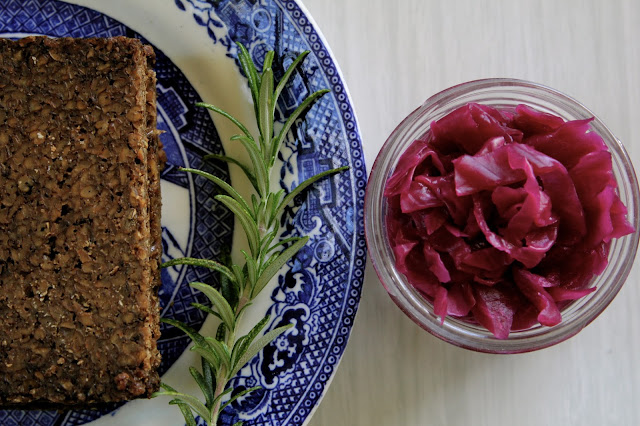
I've read two great books on fermentation in the last few months. They are: Real Food Fermentation by Alex Lewin and Wild Fermentation by Sandor Ellix Katz. Both books are really well written and got me super excited about starting some fermentation projects. I'm the kind of person who really enjoys the processes and transformations when preparing food so fermentation is my kind of fun.
My first project was kimchi and it was delicious. Next up I made some sauerkraut. I used all red cabbage so the end result is a pretty pink. That is the recipe I'm sharing today. I followed the instructions in Real Food Fermentation. It's a really straightforward recipe and doesn't require an expensive fermentation crock. You just need some clean jars. You can make it simply with just cabbage and salt as I have or add spices. Caraway, juniper or dill seed would all be fairly traditional.
 Fermentation has been used for centuries as a method of preserving food. The process gives the end product probiotic properties that make it an excellent food for digestion. This is thanks to the naturally occurring presence of the Lactobacillus bactaria. Most store bought sauerkraut has been heat treated so will have lost this natural goodness. Homemade, raw sauerkraut is really easy to make, introduces healthy bacteria into your gut and is addictively tasty.
Fermentation has been used for centuries as a method of preserving food. The process gives the end product probiotic properties that make it an excellent food for digestion. This is thanks to the naturally occurring presence of the Lactobacillus bactaria. Most store bought sauerkraut has been heat treated so will have lost this natural goodness. Homemade, raw sauerkraut is really easy to make, introduces healthy bacteria into your gut and is addictively tasty.Follow the instructions below and you'll be experiencing the satisfaction of homemade lacto fermented sauerkraut in no time.
I served mine for lunch today with some some delicious goat gouda and lightly toasted pumpernickel.
Sauerkraut - recipe adapted from Real Food Fermentation by Alex Lewin
900g sliced green or red cabbage -core and outer leaves removed (Thinly sliced cabbage will ferment quicker and become softer. Thicker slices will retain crunch).
4 teaspoons for sea salt (not iodised salt)
Place your cabbage in a really large bowl. Sprinkle with all the salt.
With clean hands, firmly massage the cabbage and work the salt through. You need to keep working the cabbage until it is pliable and you are able to squeeze liquid out. Depending on how fresh your cabbage is and how firmly you are massaging this could take about 6-10 minutes.
Pack the mixture into a large jar or several smaller jars*. Use a potato masher or a smaller jar to pack the cabbage really tightly so that all of it sits under the liquid and you've gotten rid of as many air bubbles as possible. Fermentation is an anaerobic activity. It's important that the cabbage come into contact with air as little as possible to avoid introducing stray bacteria that will spoil your sauerkraut. Ensure you leave about an inch (2.5cm) at the top between the cabbage and the lid of the jar as the cabbage will expand as it ferments.
Place the lid on the jar/s and place in a cool dark place. I leave mine in the pantry so I don't forget about them.
Check your sauerkraut every day or so. Open the jar and taste it / smell it. Use a clean fork every time and firmly pack the cabbage back under the liquid. After a few days it should get bubbly. After a few more days it will start to smell and taste sour. Your sauerkraut will get more sour as time goes on. Once it's reached a point you are happy with place it in the fridge and start enjoying.
I've let most of my recent batches ferment for 14-16 days.
*I often use a few regular sized jam jars rather than 1 big one. I like to let some of the sauerkraut ferment for longer and enjoy some younger and crunchier.



No comments:
Post a Comment